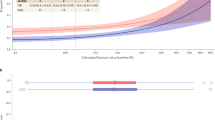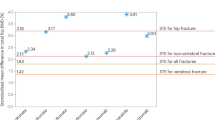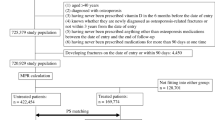Abstract
Many randomized controlled trials (RCTs) have investigated drug treatment for women at high risk of fracture, with a reduction in fracture risk as their end point. There has also been progress in identifying women at the highest risk of fractures. The most important clinical determinant contributing to the clinical decision of initiating and choosing drug therapy for fracture prevention is a woman's fracture risk, which, in RCTs, was determined by menopausal state, age, bone mineral density, fracture history, fall risks and glucocorticoid use. Women with secondary osteoporosis were excluded, except in studies of glucocorticoid use. A second determinant of drug therapy is the evidence for fracture prevention in terms of spectrum (vertebral, nonvertebral and/or hip fractures), size and speed of effect. In the absence of head-to-head RCTs with fracture risk as the end point, however, the efficacy of antifracture drugs cannot be directly compared. Other determinants include the potential extraskeletal benefits and safety concerns of the drug, patient preferences and reimbursement issues.
Key Points
-
There is strong evidence that supports the initiation of effective antifracture medications in women with postmenopausal osteoporosis or glucocorticoid-induced osteoporosis who have a high risk of fracture
-
The selection of a specific drug treatment can be based on characteristics of the patient and of the drug, and should include adequate calcium and vitamin D supplementation
-
More work is needed to match drug treatment with the underlying causes of fracture risk in an individual patient
-
Sequential treatment with anabolic and antiresorptive agents, combined with fall prevention strategies, provides a window of opportunity for the prevention of further fractures
This is a preview of subscription content, access via your institution
Access options
Subscribe to this journal
Receive 12 print issues and online access
$209.00 per year
only $17.42 per issue
Buy this article
- Purchase on Springer Link
- Instant access to full article PDF
Prices may be subject to local taxes which are calculated during checkout


Similar content being viewed by others
References
Sambrook P and Cooper C (2006) Osteoporosis. Lancet 367: 2010–2018
Geusens PP (2003) Review of guidelines for testing and treatment of osteoporosis. Curr Osteoporos Rep 1: 59–65
Kanis JA et al. (2005) Assessment of fracture risk. Osteoporos Int 16: 581–589
Khosla S and Melton LJ III (2007) Clinical practice. Osteopenia. N Engl J Med 22: 2293–2300
Kelsey JL et al. (1992) Risk factors for fractures of the distal forearm and proximal humerus. The Study of Osteoporotic Fractures Research Group. Am J Epidemiol 135: 477–489
Guyatt GH et al. (1994) Users' guides to the medical literature. II. How to use an article about therapy or prevention. B. What were the results and will they help me in caring for my patients? JAMA 271: 59–63
Stevenson M et al. (2005) A systematic review and economic evaluation of alendronate, etidronate, risedronate, raloxifene and teriparatide for the prevention and treatment of postmenopausal osteoporosis. Health Technol Assess 9: 1–160
van Staa TP (2006) The pathogenesis, epidemiology and management of glucocorticoid-induced osteoporosis. Calcif Tissue Int 79: 129–137
Riggs BL and Parfitt AM (2005) Drugs used to treat osteoporosis: the critical need for a uniform nomenclature based on their action on bone remodeling. J Bone Miner Res 20: 177–184
Black DM et al. (2007) Once-yearly zoledronic acid for treatment of postmenopausal osteoporosis. N Engl J Med 356: 1809–1822
Lyles KW et al. (2007) Zoledronic acid and clinical fractures and mortality after hip fracture. N Engl J Med 357: 1799–1809
Greenspan SL et al. (2007) Effect of recombinant human parathyroid hormone (1–84) on vertebral fracture and bone mineral density in postmenopausal women with osteoporosis: a randomized trial. Ann Intern Med 146: 326–339
Seeman E and Eisman JA (2004) 7: Treatment of osteoporosis: why, whom, when and how to treat. The single most important consideration is the individual's absolute risk of fracture. Med J Aust 180: 298–303
Roux C et al. (2007) Assessment of non-vertebral fracture risk in post-menopausal women. Ann Rheum Dis 66: 931–935
van Helden S et al. (2006) Risk of new clinical fractures within 2 years following a fracture. Osteoporos Int 17: 348–354
Center JR et al. (2007) Risk of subsequent fracture after low-trauma fracture in men and women. JAMA 297: 387–394
de Nijs RN et al. (2006) Alendronate or alfacalcidol in glucocorticoid-induced osteoporosis. N Engl J Med 355: 675–684
Lane NE et al. (1998) Parathyroid hormone treatment can reverse corticosteroid-induced osteoporosis. Results of a randomized controlled clinical trial. J Clin Invest 102: 1627–1633
Saag KG et al. (2007) Teriparatide or alendronate in glucocorticoid-induced osteoporosis. N Engl J Med 357: 2028–2039
Bischoff-Ferrari HA (2007) How to select the doses of vitamin D in the management of osteoporosis. Osteoporos Int 18: 401–407
Tannenbaum C et al. (2002) Yield of laboratory testing to identify secondary contributors to osteoporosis in otherwise healthy women. J Clin Endocrinol Metab 87: 4431–4437
US Department of Health and Human Services (2004) Bone Health and Osteoporosis: A Report of the Surgeon General. Rockville, MD: US Department of Health and Human Services
Delmas PD et al. (2003) Severity of prevalent vertebral fractures and the risk of subsequent vertebral and nonvertebral fractures: results from the MORE trial. Bone 33: 522–532
Delmas PD et al. (2004) Daily and intermittent oral ibandronate normalize bone turnover and provide significant reduction in vertebral fracture risk: results from the BONE study. Osteoporos Int 15: 792–798
Roux C et al. (2004) Efficacy of risedronate on clinical vertebral fractures within six months. Curr Med Res Opin 20: 433–439
Seeman E et al. (2006) Strontium ranelate reduces the risk of vertebral and nonvertebral fractures in women eighty years of age and older. J Bone Miner Res 21: 1113–1120
Hochberg MC et al. (2005) Effect of alendronate on the age-specific incidence of symptomatic osteoporotic fractures. J Bone Miner Res 20: 971–976
Boonen S et al. (2004) Safety and efficacy of risedronate in reducing fracture risk in osteoporotic women aged 80 and older: implications for the use of antiresorptive agents in the old and oldest old. J Am Geriatr Soc 52: 1832–1839
Marcus R et al. (2003) The skeletal response to teriparatide is largely independent of age, initial bone mineral density, and prevalent vertebral fractures in postmenopausal women with osteoporosis. J Bone Miner Res 18: 18–23
Gøtzsche PC et al. (2007) Data extraction errors in meta-analyses that use standardized mean differences. JAMA 298: 430–437
Liberman UA et al. (2006) Hip and non-spine fracture risk reductions differ among antiresorptive agents: Evidence from randomised controlled trials. Int J Clin Pract 60: 1394–1400
Boonen S et al. (2005) Effect of osteoporosis treatments on risk of non-vertebral fractures: review and meta-analysis of intention-to-treat studies. Osteoporos Int 16: 1291–1298
Rosen CJ et al. (2005) Treatment with once-weekly alendronate 70 mg compared with once-weekly risedronate 35 mg in women with postmenopausal osteoporosis: a randomized double-blind study. J Bone Miner Res 20: 141–151
Ferrari S and Rizzoli R (2007) Risedronate or alendronate for the prevention of osteoporotic fractures: is there a real difference? Bonekey Osteovision 4: 141–143
Silverman SL et al. (2007) Effectiveness of bisphosphonates on nonvertebral and hip fractures in the first year of therapy: the risedronate and alendronate (REAL) cohort study. Osteoporos Int 18: 25–34
Russell RG (2006) Bisphosphonates: from bench to bedside. Ann N Y Acad Sci 1068: 367–401
Homik J et al. Calcium and vitamin D for corticosteroid-induced osteoporosis. Cochrane Database of Systematic Reviews 1998, Issue 1. Art. No.: CD000952.10.1002/14651858.CD000952
Martino S et al. (2004) Continuing outcomes relevant to Evista: breast cancer incidence in postmenopausal osteoporotic women in a randomized trial of raloxifene. J Natl Cancer Inst 96: 1751–1761
Rossouw JE et al. (2002) Risks and benefits of estrogen plus progestin in healthy postmenopausal women: principle results from the Women's Health Initiative randomized controlled trial. JAMA 288: 321–333
Shane E et al. (2006) Osteonecrosis of the jaw: more research needed. J Bone Miner Res 21: 1503–1505
Odvina CV et al. (2005) Severely suppressed bone turnover: a potential complication of alendronate therapy. J Clin Endocrinol Metab 90: 1294–1301
Chapurlat RD et al. (2007) Microcrack frequency and bone remodeling in postmenopausal osteoporotic women on long-term bisphosphonates: a bone biopsy study. J Bone Miner Res 22: 1502–1509
Berenson JR (2005) Recommendations for zoledronic acid treatment of patients with bone metastases. Oncologist 10: 52–62
Cummings SR et al. (2007) Alendronate and atrial fibrillation. N Engl J Med 356: 1895–1896
Karam R et al. (2007) Yearly zoledronic acid in postmenopausal osteoporosis. N Engl J Med 357: 712–713
European Medicines Agency (2007) Press Release: EMEA recommends changes in the product information for Protelos/Osseor due to the risk of severe hypersensitivity reactions [www.emea.europa.eu./humandocs/PDFs/EPAR/protelos/PressRelease_ Protelos_41745807en.pdf] (accessed 13 February 2008)
Vahle JL et al. (2004) Bone neoplasms in F344 rats given teriparatide [rhPTH(1–34)] are dependent on duration of treatment and dose. Toxicol Pathol 32: 426–438
Greenspan SL et al. (2003) Combination therapy with hormone replacement and alendronate for prevention of bone loss in elderly women: a randomized controlled trial. JAMA 289: 2525–2533
Black DM et al. (2003) The effects of parathyroid hormone and alendronate alone or in combination in postmenopausal osteoporosis. N Engl J Med 349: 1207–1215
Finkelstein JS et al. (2003) The effects of parathyroid hormone, alendronate, or both in men with osteoporosis. N Engl J Med 349: 1216–1226
Cosman F et al. (2005) Daily and cyclic parathyroid hormone in women receiving alendronate. N Engl J Med 353: 566–575
Black DM et al. (2005) One year of alendronate after one year of parathyroid hormone (1–84) for osteoporosis. N Engl J Med 353: 555–565
Rubin MR and Bilezikian JP (2005) Parathyroid hormone as an anabolic skeletal therapy. Drugs 65: 2481–2498
Siris ES et al. (2006) Adherence to bisphosphonate therapy and fracture rates in osteoporotic women: relationship to vertebral and nonvertebral fractures from 2 US claims databases. Mayo Clin Proc 81: 1013–1022
Bliuc D et al. (2005) Barriers to effective management of osteoporosis in moderate and minimal trauma fractures: a prospective study. Osteoporos Int 16: 977–982
Epstein S et al. (2005) Disintegration and esophageal irritation profiles of alendronate formulations: implications for clinical safety and efficacy. J Applied Res 5: 253–265
Damiano J et al. (2006) Diagnosis of vertebral fractures by vertebral fracture assessment. J Clin Densitom 9: 66–71
Bouxsein ML (2005) Determinants of skeletal fragility. Best Pract Res Clin Rheumatol 19: 897–911
Ralston SH and de Crombrugghe B (2006) Genetic regulation of bone mass and susceptibility to osteoporosis. Genes Dev 20: 2492–2506
van Helden S et al. (2008) Bone and fall-related fracture risks in women and men with a recent clinical fracture. J Bone Joint Surg Am 90: 241–248
Canalis E et al. (2007) Mechanisms of anabolic therapies for osteoporosis. N Engl J Med 357: 905–916
Margolis RN and Wimalawansa SJ (2006) Novel targets and therapeutics for bone loss. Ann N Y Acad Sci 1068: 402–409
Acknowledgements
Désirée Lie, University of California, Irvine, CA, is the author of and is solely responsible for the content of the learning objectives, questions and answers of the Medscape-accredited continuing medical education activity associated with this article.
Author information
Authors and Affiliations
Corresponding author
Ethics declarations
Competing interests
PP Geusens has participated in speakers bureaus (honoraria) and has received grant/research support (including clinical trials) from Eli Lily, Merck, Procter and Gamble Pharmaceuticals, Roche and Servier.
CH Roux has participated in speakers bureaus (honoraria) for Actelion, the Alliance for Better Bone Health (Procter and Gamble Pharmaceuticals and Sanofi-Aventis), GlaxoSmithKline, Eli Lily, Merck, Novartis Pharmaceuticals, Nycomed, Roche and Servier.
DM Reid has participated in speakers bureaus (honoraria) for, and has received grant/research support (including clinical trials) from, Novartis and Roche, and has acted as a consultant for Roche, Procter and Gamble Pharmaceuticals, and Amgen.
WF Lems has participated in speakers bureaus (honoraria) for the Alliance for Better Bone Health (Procter and Gamble Pharmaceuticals and Sanofi-Aventis), Eli Lily, Merck, Roche and Servier.
S Adami declared no competing interests.
JD Adachi has participated in speakers bureaus (honoraria) for Amgen, Eli Lily, GlaxoSmithKline, Merck, Novartis Pharmaceuticals, Pfizer, Procter and Gamble Pharmaceuticals, Roche, Sanofi-Aventis and Servier.
PN Sambrook declared no competing interests.
KG Saag has participated in speakers bureaus (honoraria) for Merck and Amgen, has received grant/research support (including clinical trials) from Amgen, Eli Lily, Novartis, Roche, Procter and Gamble Pharmaceuticals and Sanofi-Aventis, and has acted as a consultant for Amgen, Eli Lily, Merck, Novartis, Roche, Procter and Gamble Pharmaceuticals and Sanofi-Aventis.
NE Lane declared no competing interests.
MC Hochberg has acted as a consultant for Amgen, Merck, Novartis Pharmaceuticals, Procter and Gamble Pharmaceuticals and Roche.
Rights and permissions
About this article
Cite this article
Geusens, P., Roux, C., Reid, D. et al. Drug Insight: choosing a drug treatment strategy for women with osteoporosis—an evidence-based clinical perspective. Nat Rev Rheumatol 4, 240–248 (2008). https://doi.org/10.1038/ncprheum0773
Received:
Accepted:
Published:
Issue Date:
DOI: https://doi.org/10.1038/ncprheum0773
This article is cited by
-
Compliance and persistence with oral bisphosphonates for the treatment of osteoporosis in female patients with rheumatoid arthritis
BMC Musculoskeletal Disorders (2017)
-
Adherence to osteoporosis regimens among men and analysis of risk factors of poor compliance: a 2-year analytical review
BMC Musculoskeletal Disorders (2013)
-
Compliance and treatment satisfaction of post menopausal women treated for osteoporosis. Compliance with osteoporosis treatment
BMC Women's Health (2010)
-
Adherence to monthly and weekly oral bisphosphonates in women with osteoporosis
Osteoporosis International (2010)
-
Bisphosphonates for postmenopausal osteoporosis: Determining duration of treatment
Current Osteoporosis Reports (2009)



